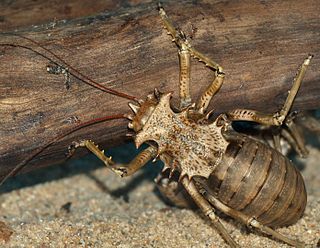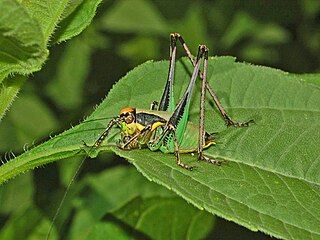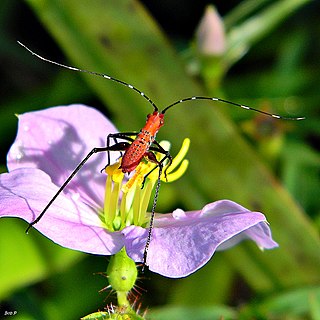
Insects in the family Tettigoniidae are commonly called katydids, or bush crickets. They have previously been known as "long-horned grasshoppers". More than 8,000 species are known. Part of the suborder Ensifera, the Tettigoniidae are the only extant (living) family in the superfamily Tettigonioidea.

Orthoptera is an order of insects that comprises the grasshoppers, locusts, and crickets, including closely related insects, such as the bush crickets or katydids and wētā. The order is subdivided into two suborders: Caelifera – grasshoppers, locusts, and close relatives; and Ensifera – crickets and close relatives.

Ensifera is a suborder of insects that includes the various types of crickets and their allies including: true crickets, camel crickets, bush crickets or katydids, grigs, weta and Cooloola monsters. This and the suborder Caelifera make up the order Orthoptera. Ensifera is believed to be a more ancient group than Caelifera, with its origins in the Carboniferous period, the split having occurred at the end of the Permian period. Unlike the Caelifera, the Ensifera contain numerous members that are partially carnivorous, feeding on other insects, as well as plants.

Crickets are orthopteran insects which are related to bush crickets, and, more distantly, to grasshoppers. In older literature, such as Imms, "crickets" were placed at the family level, but contemporary authorities including Otte now place them in the superfamily Grylloidea. The word has been used in combination to describe more distantly related taxa in the suborder Ensifera, such as king crickets and mole crickets.

Macroxiphus is a small genus of bush crickets or katydids distributed in Southeast Asia and Micronesia. The nymphs of the insects mimic ants.

Eugaster spinulosa is a species of bush-cricket from Morocco.
Panoploscelis is a genus of very large insects belonging to the true katydid tribe Eucocconotini, which is a subfamily of the Tettigoniidae. Like the other members of the suborder Ensifera, Panoploscelis are part of the insect order Orthoptera, which also contains crickets, grasshoppers and locusts. Members of this genus are among the largest katydids of the Neotropics.

Eupholidoptera is a genus of bush crickets belonging to the subfamily Tettigoniinae.

Orchelimum gladiator is a species of katydid that has the common names gladiator meadow katydid and gladiator katydid.

Scudderia cuneata is a species in the family Tettigoniidae ("katydids"), in the order Orthoptera. A common name for Scudderia cuneata is "southeastern bush katydid". Scudderia cuneata is found in North America.

Scudderia curvicauda is a species in the family Tettigoniidae ("katydids"), in the order Orthoptera. A common name for Scudderia curvicauda is "curve-tailed bush katydid". Scudderia curvicauda is found in North America.

Scudderia furcata is a species in the family Tettigoniidae ("katydids"), in the order Orthoptera. A common name for Scudderia furcata is fork-tailed bush katydid. The distribution range of Scudderia furcata includes Central America and North America.

Scudderia pistillata is a species in the family Tettigoniidae ("katydids"), in the order Orthoptera. A common name for Scudderia pistillata is "broad-winged bush katydid". Scudderia pistillata is found in North America.

Tettigoniidea is an infraorder of the order Orthoptera, with six extant families.
Insara is a genus known as "western bush katydids": characteristic of the tribe Insarini and placed in the family Tettigoniidae, subfamily Phaneropterinae. There are about 6 described species in Insara.

Neoconocephalus retusus, the round-tipped conehead, is a species of katydid or bush cricket in the family Tettigoniidae. It is found in the eastern United States and southern Canada.

Caedicia simplex is a species of bush cricket, native to New Zealand. It is also found in Australia. Its common name is the common garden katydid.

Hemiandrus maculifrons is a species of ground wētā endemic to New Zealand. They are nocturnal, carnivorous, and flightless orthopterans belonging to the family Anostostomatidae. Being a nocturnal species, individuals remain in tunnels in the ground during the day and emerge from their burrows after sunset to forage and hunt for small invertebrates. H. maculifrons is one of the smallest New Zealand weta species, averaging 15 mm in length and weighing 1–3 g. Unlike the tree weta and tusked weta, where sexual dimorphism is found in the form of male weaponry, ground weta only exhibit sexual size dimorphism: the females are larger than the males.
















